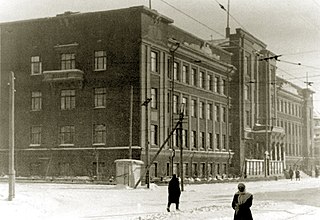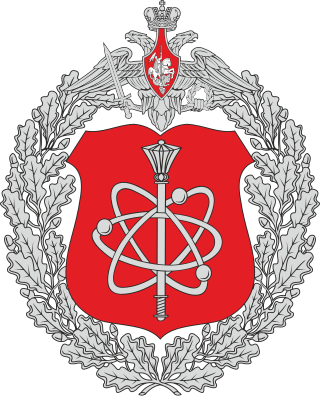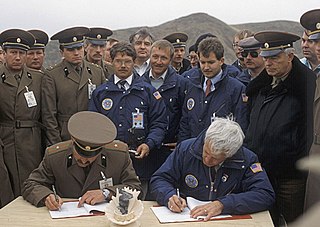Related Research Articles

Biological warfare, also known as germ warfare, is the use of biological toxins or infectious agents such as bacteria, viruses, insects, and fungi with the intent to kill, harm or incapacitate humans, animals or plants as an act of war. Biological weapons are living organisms or replicating entities. Entomological (insect) warfare is a subtype of biological warfare.

Sharashkas were secret research and development laboratories operating from 1930 to the 1950s within the Soviet Gulag labor camp system, as well as in other facilities under the supervision of the Soviet secret service. Formally various secret R&D facilities were called "special design bureau" Russian: особое конструкторское бюро, ОКБ and similar terms. Etymologically, the word sharashka derives from a Russian slang expression sharashkina kontora,, an ironic, derogatory term to denote a poorly-organized, impromptu, or bluffing organization, which in its turn comes from the criminal argot term sharaga (шарага) for a band of thieves, hoodlums, etc.)
The All-Union Science Production Association Biopreparat was a Soviet agency created in April 1974, which spearheaded the largest and most sophisticated offensive biological warfare program the world has ever seen. It was a vast, ostensibly civilian, network employing 30–40,000 personnel and incorporating five major military-focused research institutes, numerous design and instrument-making facilities, three pilot plants and five dual-use production plants. The network pursued major offensive research and development programs which genetically engineered microbial strains to be resistant to an array of antibiotics. In addition, bacterial agents were created with the ability to produce various peptides, yielding strains with wholly new and unexpected pathogenic properties.

The Biological Weapons Convention (BWC), or Biological and Toxin Weapons Convention (BTWC), is a disarmament treaty that effectively bans biological and toxin weapons by prohibiting their development, production, acquisition, transfer, stockpiling and use. The treaty's full name is the Convention on the Prohibition of the Development, Production and Stockpiling of Bacteriological (Biological) and Toxin Weapons and on their Destruction.

Porton Down is a science and defence technology campus in Wiltshire, England, just north-east of the village of Porton, near Salisbury. It is home to two British government facilities: a site of the Ministry of Defence's Defence Science and Technology Laboratory – known for over 100 years as one of the UK's most secretive and controversial military research facilities, occupying 7,000 acres (2,800 ha) – and a site of the UK Health Security Agency. Since 2018, part of the campus has housed Porton Science Park, which is owned and operated by Wiltshire Council and has private sector companies in the health, life science and defence and security sectors.

The Semipalatinsk Test Site, also known as "The Polygon", was the primary testing venue for the Soviet Union's nuclear weapons. It is located on the steppe in northeast Kazakhstan, south of the valley of the Irtysh River. The scientific buildings for the test site were located around 150 km (93 mi) west of the town of Semipalatinsk, later renamed Semey, near the border of East Kazakhstan Region and Pavlodar Region. Most of the nuclear tests taking place at various sites further to the west and the south, some as far as into Karagandy Region.

Kanatzhan "Kanat" Baizakovich Alibekov, known as Kenneth "Ken" Alibek since 1992, is a Kazakh-American microbiologist, bioweaponeer, and biological warfare administrative management expert. He is a certified oncologist, a doctor of science, doctor of philosophy and a doctor of medicine.
Israel Institute for Biological Research (IIBR) is an Israeli research and development laboratory It is under the jurisdiction of the Prime Minister's Office that works in close cooperation with Israeli government agencies. IIBR has many public projects on which it works with international research organizations and universities. It has approximately 350 employees, 150 of whom are scientists. Its research findings are often published in national and international scientific publications. It is widely believed to be involved in the manufacturing of biological and chemical weapons. The IIBR is currently developing a COVID-19 vaccine Brilife.

Vozrozhdeniya Island was an island in the Aral Sea. The former island's territory is split between Uzbekistan and Kazakhstan. In 1954, the Soviet Union constructed a biological weapons test site called Aralsk-7 there and on the neighbouring Komsomolskiy Island, which also no longer exists.
On 2 April 1979, spores of Bacillus anthracis were accidentally released from a Soviet military research facility in the city of Sverdlovsk, Soviet Union. The ensuing outbreak of the disease resulted in the deaths of at least 68 people, although the exact number of victims remains unknown. The cause of the outbreak was denied for years by the Soviet authorities, which blamed the deaths on consumption of tainted meat from the area, and subcutaneous exposure due to butchers handling the tainted meat. The accident was the first major indication in the Western world that the Soviet Union had embarked upon an offensive programme aimed at the development and large-scale production of biological weapons.

Stepnogorsk is a town in Akmola Region, Kazakhstan.
Erich Traub was a German veterinarian, scientist and virologist who specialized in foot-and-mouth disease, Rinderpest and Newcastle disease. Traub was a member of the National Socialist Motor Corps (NSKK), a Nazi motorist corps, from 1938 to 1942. He worked directly for Heinrich Himmler, head of the Schutzstaffel (SS), as the lab chief of the Nazis' leading bio-weapons facility on Riems Island.

The Soviet Union covertly operated the world's largest, longest, and most sophisticated biological weapons program, thereby violating its obligations as a party to the 1972 Biological Weapons Convention. The program began in the 1920s and lasted until at least September 1992 but has possibly been continued by Russia after that.

The Imam Hossein Comprehensive University is a public university located in Tehran, Iran.
The People's Commissariat for Agriculture, abbreviated as Narkomzem was established in the RSFSR following the October Revolution. When the RSFSR joined the other Soviet republics to form the Union of Soviet Socialist Republics (USSR), agriculture was to be an area of policy governed exclusively by the individual union republics and Narkomzem remained a Commissariat of the RSFSR and other respective Soviet Socialist Republics. Coinciding with the onset of the policy of mass collectivisation of agriculture and the Five Year Plan, it was decided to create a union-level People's Commissariat for Agriculture of the USSR in 1929 which would exist above the republic-level People's Commissariats of Agriculture. Its headquarters building was located at Orlikov Pereulok, 1, Moscow, designed by Aleksey Shchusev in 1928. Narkomzem was reformed as the Soviet Ministry of Agriculture and Food (Minsel'khoz) in 1946.

The 12th Chief Directorate of the Ministry of Defense of the former Soviet Union and of the Russian Federation after 1991 (Russian: 12 Главное Управление Министерства Обороны СССР/РФ is a department within the Russian Ministry of Defense. It is responsible for the safe-keeping, technical maintenance, transportation, delivery, issuance, disposal, etc. of the nuclear arsenal of the state, as well as the testing of nuclear charges, which includes ensuring ecological safety of such tests and the maintenance of Soviet/Russian testing grounds, known in Russian as "polygons" – in Semipalatinsk and on Novaya Zemlya Archipelago.
The United States Biological Defense Program—in recent years also called the National Biodefense Strategy—refers to the collective effort by all levels of government, along with private enterprise and other stakeholders, in the United States to carry out biodefense activities.

The All-Russian Scientific Research Institute of Experimental Physics (VNIIEF) is a research institute based in Sarov, Russia and established in 1947. During the Soviet era, it was known as KB-11 and All-Soviet (All-Union) Scientific Research Institute of Experimental Physics. It is currently part of the Rosatom group.
The State Research Center for Applied Microbiology is a research laboratory in Obolensk, Moscow Oblast.

The Republic of Kazakhstan, once a republic of the Soviet Union, was a primary venue for Soviet nuclear weapon testing from 1949 until 1989. Following the collapse of the Union of Soviet Socialist Republics (USSR) in 1991, Kazakhstan became the fourth-largest nuclear power in the world and hosted a considerably large weapon support infrastructure due to its reliance on the Soviet nuclear program as a means to develop its own local economy. Besides the nuclear program, Kazakhstan was also a prominent site of Soviet programs of biological and chemical weapons.
References
- ↑ "Stepnogorsk / Stepnagorsk Scientific and Technical Institute for Microbiology". Globalsecurity.org. 1998.
- 1 2 3 Miller, Judith; Engelberg, Stephen; and Broad, William. Germs: Biological Weapons and America's Secret War. New York: Simon and Schuster, Inc., 2002.